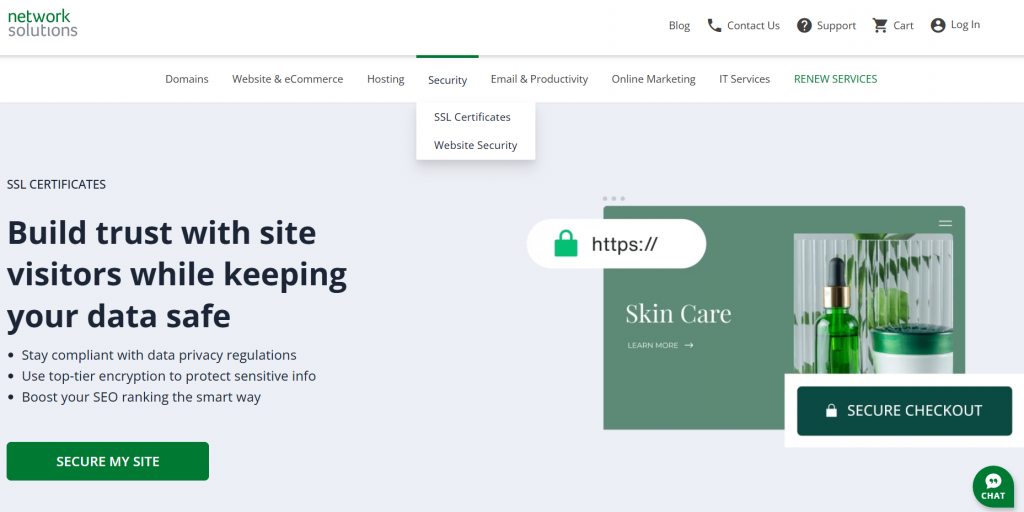Key takeaways:
- SSL and HTTPS are two different website security tools, but they work together to keep websites safe.
- Serving as the encryption technology, SSL encrypts transmitted data. HTTPS, on the other hand, uses this technology to guarantee that the connection between the browser and server remains protected.
- With more than 95% of Google Chrome traffic encrypted via HTTPS in 2024, it’s clear that HTTPS is now the dominant security protocol for websites worldwide.
Security is an absolute must when owning a website. According to a study from Check Point Research, there has been a 30% increase in cyberattacks globally. With the rampant cases of various cyberattacks, keeping your website and customer information safe should be your top priority.
One of the most effective ways to secure your website from cyberattacks is to add an SSL certificate and HTTPS. But what is the difference between HTTPS and SSL?
This guide will define an SSL certificate and HTTPS and explain how they work together to secure your website.
What is SSL?
Secure Sockets Layer (SSL), a security tool originally developed in the 1990s, encrypts the data transferred between a web browser and a site’s server. Specifically, it conceals sensitive information such as payment details, login credentials, and personal data while in transit, thereby preventing cybercriminals from stealing data during a transaction.
SSL vs. TLS
Secure Sockets Layer was the first protocol designed to secure data during transit. However, several vulnerabilities were discovered in SSL, such as:
- Poodle (Padding Oracle)
- BEAST (Browser Exploit Against SSL/TLS)
- CRIME (Compression Ratio Info-leak Make Easy)
- Heartbleed
As a result, Transport Layer Security (TLS) was developed to patch these flaws and improve security.
To put it simply, TLS is the secure and latest version of SSL. TLS improves upon SSL’s encryption by using stronger cryptographic algorithms and addressing known vulnerabilities. While TLS is now the preferred and more secure protocol, many people still refer to it as “SSL” due to its historical use.
How does SSL encryption work?
The core of SSL/TLS technology are encryption and decryption processes. These processes are what make your website’s data safe. Moreover, they rely on a combination of public key and private key cryptographic protocols to initiate a secure connection between the website user’s browser and the internet server.
Here’s how it works:
Public and private key
The SSL protocol utilizes a public key for encrypting information and a private key for decrypting information. The public key is made available to anyone who visits your website, while the private key remains securely stored on the server.
Encryption and decryption processes
Once the user begins the connection with a secure website (using HTTPS), the browser and server start an SSL handshake. This process involves exchanging keys and acknowledging encryption methods. An encryption connection is established during the process, which makes sure that all information that was exchanged remains private and secure.
What is hypertext transfer protocol secure (HTTPS)?
The hypertext transfer protocol secure (HTTPS) is essentially a more secure and improved form of the hypertext transfer protocol (HTTP), the primary protocol used to transmit data online. It helps websites initiate secure and encrypted connections to ensure the data exchange stays hidden and protected.
Most websites nowadays have secured HTTPS to provide security when transferring sensitive information, such as payment processing and user login credentials. In fact, as of 2024, over 95% of website traffic in Google Chrome is now protected by HTTPS. This shows how HTTPS has become the global standard for website security.
Key benefits of using HTTPS include:
- Encrypts sensitive data such as credit card info, passwords, and contact details
- Boosts user trust and conversions with the padlock icon and secure label
- Improves SEO rankings (Google uses HTTPS as a ranking factor)
- Protects data integrity by preventing tampering during transmission
HTTPS vs. HTTP
HTTP and HTTPS, while similar in their basic function of transmitting data, differ in terms of security.
HTTP stands for Hypertext Transfer Protocol. Basically, it’s the standard protocol used for transmitting data across the web. However, with HTTP, any information you send, such as passwords or personal details, can be exposed because the data is not encrypted.
And as already established, HTTPS is a secure version of HTTP. HTTPS solves the problem of data exposure by encrypting the data packets through SSL/TLS, which keeps your data private and safe from hackers.
When a website uses HTTPS, you’ll usually see a small padlock icon in your browser’s URL bar. That’s a sign the connection is secure. On the other hand, if a site doesn’t use HTTPS, browsers like Chrome or Firefox shows a “Not Secure” warning.
How does HTTPS work?
When you see “https://” in front of the website’s URL, it signifies that the site has a secure, encrypted connection between web browsers and internet servers.
Here’s how HTTPS works to secure your website:
Establishing a secure connection
When a user enters your website’s URL with HTTPS, their web browser initiates a “handshake” with your web server. Your server provides the browser with an SSL certificate during this procedure. This certificate serves as evidence that your website is trustworthy and authentic.
Encrypting the data
The web browser encrypts the data packets using the SSL certificate’s public key after verifying it. Through the private key, your server will be the only one able to decode any data sent back and forth between the user and your website. This prevents unauthorized third parties and hackers from accessing the data while it’s in transit.
Seamless user experience
Your visitors will have a seamless, safe connection because all of this is happening behind the scenes. When they see the padlock icon and “HTTPS” in the address field, it instantly boosts your site’s credibility and reassures them that their interactions are secure, fostering greater trust in your website.
SSL vs HTTPS: How are they different?
In comparing SSL vs HTTPS, it’s important to understand that HTTPS is the secure variant of the HTTP protocol, whereas SSL refers to the encryption procedure itself. Although they cooperate to guarantee the security of your website, they are not the same thing.
- SSL is the encryption protocol used to secure data.
- HTTPS is a secure web communication protocol that uses SSL/TLS to protect transmitted data.
Here’s a quick overview of their differences:
| Aspect | SSL | HTTPS |
| What it is | Security protocol (now largely replaced by TLS) | Secure version of the HTTP protocol |
| Primary role | Encrypts and decrypts data | Secures data in transit using SSL/TLS |
| Used for | Creating/installing digital certificates | Transmitting secure data between browser & server |
| Implementation | Installed on server as a certificate | Requires SSL/TLS certificate to activate |
| Protocol scope | Works beyond websites (e.g., email, FTP, VoIP) | Used specifically for secure web communication |
| Browser indicator | Not directly visible to average users | Padlock icon and “https://” at the beginning of the web address |
| Current usage | Replaced by TLS | Actively used across modern websites |
| SEO impact | Indirect (relates to security but no direct impact) | Direct (Google prefers HTTPS-enabled sites) |
Here’s a deeper look at their roles, purposes, and how they work together to ensure secure communication:
Purpose
- SSL encrypts data to keep it private during internet transmission.
- HTTPS is the framework used for secure communication over the internet, indicating that a website uses SSL/TLS to protect user data. It ensures that users can trust the site with their information.
Usage
- SSL is primarily focused on establishing a secure connection and is not limited to web traffic; it can also secure email, file transfers, and other types of data communication.
- HTTPS specifically pertains to web browsing. It is the protocol users see in their browser’s address bar, signifying that the website is secure.
Browser indicator
- When a site uses SSL, the connection is secure, but users may not see a specific indicator unless they know how to check the security certificate.
- When a site uses HTTPS, users typically see a padlock symbol beside the website’s URL in your browser, clearly indicating a secure connection.
Implementation
- To use SSL, a website needs to have an SSL certificate installed on its server. This is necessary for encrypting the data exchanged between the server hosting the site and the site user’s browser. This certificate is usually issued by a trusted Certificate Authority (CA) and includes details that authenticate the identity of the website owner. This process establishes the encryption layer.
- To use HTTPS, you must ensure that SSL/TLS is enabled and properly configured on the server. Once SSL is in place, the HTTP protocol is modified to HTTPS by updating the website’s URLs to https://. This allows the web server to handle secure requests via SSL/TLS. If SSL is not installed, the site cannot use HTTPS.
SEO impact
- While SSL itself does not directly impact SEO, it’s a vital part of the overall HTTPS implementation. Google considers HTTPS a ranking signal, so SSL is indirectly important for SEO. Sites that don’t use SSL or HTTPS might face issues with trust and ranking.
- HTTPS has a direct impact on SEO rankings. That’s because Google takes HTTPS into account when ranking sites. Therefore, websites using HTTPS are more likely to rank higher than those that don’t. On the flip side, Google Chrome and other browsers display warnings like “Not Secure” for HTTP websites, which can deter users and negatively affect your site’s trustworthiness and SEO performance.
How do SSL and HTTPS work together?
SSL and HTTPS are security tools that serve different purposes but complement each other.
SSL/TLS is the encryption technology, while HTTPS is the secure communication protocol. Combined, they safeguard the data being transferred between your web server and users, concealing it from unauthorized access.
The combination of SSL/TLS and HTTPS is what gives websites the padlock icon and the prefix https:// in the browser’s address bar. This sends a signal to users that your site is well protected and that any data being transmitted on your site is protected and secure.
What are the risks of not using SSL on your website?
Now that you know the role of an SSL in HTTPS, let’s talk about why having an SSL certificate is important. Here’s a list of risks on websites without SSL certificates:
- Data interception
- Loss of customer trust
- Negative SEO impact
- Compliance issues
- Increased vulnerability to phishing
- Browser warnings
- Legal and financial consequences
Data interception
Without SSL, data transmitted between your website and users, such as login credentials, payment information, or personal details, can be intercepted by hackers. This interception can occur when attackers capture and decode sensitive info as it travels over the internet.
Loss of customer trust
It’s not only a technical problem if your website isn’t secure. If visitors believe their data may be in danger, they will hesitate to interact with your website, share personal information, or make purchases. This lack of trust can cause a drop in conversions and hurt customer loyalty.
Negative SEO impact
Search engines prioritize secure websites in their rankings. Sites without SSL may experience a negative impact on SEO efforts.
Google, for instance, considers HTTPS as a ranking signal and may rank HTTPS-enabled sites higher than those without SSL, which can affect your site’s visibility.
Plus, if your visitors don’t trust your website, then your organic traffic decreases. This tells search engines your website isn’t relevant, decreasing your search ranking.
Compliance issues
If your website processes personal or financial data, not using SSL could violate industry regulations and compliance standards. The Payment Card Industry Data Security Standard (PCI-DSS), for instance, mandates the use of strong encryption mechanisms like SSL to protect cardholder data during transmission over public networks.
Non-compliance could lead to penalties, fines, or even restrictions on conducting online transactions.
Increased vulnerability to phishing
Websites without SSL are easier targets for phishing attacks. Phishing involves cybercriminals impersonating legitimate websites to deceive users into divulging sensitive information.
Without SSL, attackers can more easily intercept communication between your site and users, facilitating phishing attempts that exploit trust and compromise user security.
Browser warnings
Web browsers today show warnings to users when they attempt to visit sites without an SSL certificate. These warnings alert users to potential security risks, such as “Not Secure” messages in the browser address bar.
Such warnings can deter visitors from accessing your site, adversely impacting traffic, credibility, and user experience.
Legal and financial consequences
In the event of a data breach or non-compliance with privacy laws, websites without SSL could face significant legal and financial repercussions. Depending on the jurisdiction and nature of the breach, consequences may include:
- legal liabilities
- regulatory fines
- remediation costs
- damage to brand reputation
How to get an SSL certificate with Network Solutions
With Network Solutions, the process of acquiring an SSL certificate is straightforward:
- Proceed to Network Solution’ website and select the Security tab.

2. Choose SSL certificates, and then select which plan will suit your website most.

3. Add the SSL certificate on your web server. This step will often require technical assistance, but with Network Solutions’ reliable hosting platform, the drag-and-drop editor will make the integration easy.
4. Ensure your website uses HTTPS and displays the lock symbol in the address bar.
5. After you install the SSL certificate, your website will be secure with SSL/TLS encryption, which means users can browse safely.
Protect your site with Network Solutions’ other security tools
At Network Solutions, we take website security as a priority. Aside from an SSL certificate, we also offer other security features to help you create a safe web experience for your customers.
SiteLock security

Add Sitelock protection to your website to secure your data and prevent malware from accessing it. Identifying weaknesses and stopping harmful activity before it compromises your data guards against fraudulent activity on your website.
In addition to automatically scanning and preventing malware installation to eliminate the threat, this function protects your customers’ data from hackers, gaining their trust.
Domain Privacy + Protection

Shielding your website is just one step ahead of cyber attackers. Adding Domain Privacy + Protection will keep your website from two potential online threats: hackers and human error.
This security tool keeps your domain safe from third-party spammers and identity theft, masking your private details from the WHOIS database. You’re safeguarding not only your domain and website but also your reputation.
Secure your website with SSL/TLS and HTTPS
SSL/TLS and HTTPS are just two of the many security technologies that keep your website safe. While they work together to protect your site, they’re actually two different things.
With an SSL certificate, you enable that encryption for all the sensitive data flowing between your website and visitors. And with HTTPS, you’re making sure your site stands out as a safe place to interact with.
To enhance your website’s security, choose the right SSL certificate from Network Solutions and ensure your site is well protected.
Frequently asked questions
No, HTTPS is not SSL. HTTPS is a protocol that relies on SSL/TLS to protect communication between the browser and the server. SSL is the underlying encryption technology, while HTTPS is the secure version of HTTP.
Yes, HTTPS uses SSL/TLS to secure website traffic. SSL is the technology that encrypts data, while HTTPS is the protocol that applies SSL to ensure protected communication over the web.
SSL (or TLS, its updated version) is the underlying technology that enables secure connections. HTTPS is the protocol that employs SSL to secure communication over the web. So, they’re not directly comparable since they serve different functions but work together to provide security.
SSL is outdated because of security vulnerabilities. TLS (Transport Layer Security) replaced SSL as a more secure protocol for encrypting data. While TLS is now the standard in modern browsers, “SSL” continues to be the popular term for secure certificates.
Yes, HTTPS cannot function without SSL or TLS. The SSL/TLS encryption is what makes HTTP secure, ensuring that data exchanged between the server and the browser remains protected.
Technically, yes. SSL can secure various types of data exchanges, but HTTPS is the specific protocol for securing web traffic. Without HTTPS, SSL wouldn’t be used for web browsing.
Google gives websites with HTTPS higher priority in search rankings, which helps your site appear higher in search results.




